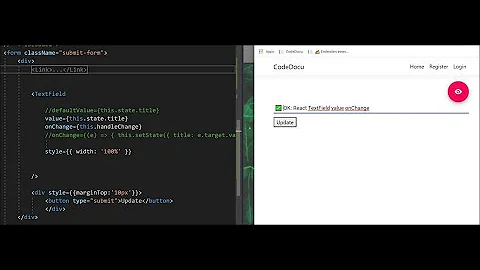React.js: onChange event for contentEditable
Solution 1
Edit: See Sebastien Lorber's answer which fixes a bug in my implementation.
Use the onInput event, and optionally onBlur as a fallback. You might want to save the previous contents to prevent sending extra events.
I'd personally have this as my render function.
var handleChange = function(event){
this.setState({html: event.target.value});
}.bind(this);
return (<ContentEditable html={this.state.html} onChange={handleChange} />);
jsbin
Which uses this simple wrapper around contentEditable.
var ContentEditable = React.createClass({
render: function(){
return <div
onInput={this.emitChange}
onBlur={this.emitChange}
contentEditable
dangerouslySetInnerHTML={{__html: this.props.html}}></div>;
},
shouldComponentUpdate: function(nextProps){
return nextProps.html !== this.getDOMNode().innerHTML;
},
emitChange: function(){
var html = this.getDOMNode().innerHTML;
if (this.props.onChange && html !== this.lastHtml) {
this.props.onChange({
target: {
value: html
}
});
}
this.lastHtml = html;
}
});
Solution 2
This is the is simplest solution that worked for me.
<div
contentEditable='true'
onInput={e => console.log('Text inside div', e.currentTarget.textContent)}
>
Text inside div
</div>
Solution 3
Edit 2015
Someone has made a project on NPM with my solution: https://github.com/lovasoa/react-contenteditable
Edit 06/2016: I've just encoutered a new problem that occurs when the browser tries to "reformat" the html you just gave him, leading to component always re-rendering. See
Edit 07/2016: here's my production contentEditable implementation. It has some additional options over react-contenteditable that you might want, including:
- locking
- imperative API allowing to embed html fragments
- ability to reformat the content
Summary:
FakeRainBrigand's solution has worked quite fine for me for some time until I got new problems. ContentEditables are a pain, and are not really easy to deal with React...
This JSFiddle demonstrates the problem.
As you can see, when you type some characters and click on Clear, the content is not cleared. This is because we try to reset the contenteditable to the last known virtual dom value.
So it seems that:
- You need
shouldComponentUpdateto prevent caret position jumps - You can't rely on React's VDOM diffing algorithm if you use
shouldComponentUpdatethis way.
So you need an extra line so that whenever shouldComponentUpdate returns yes, you are sure the DOM content is actually updated.
So the version here adds a componentDidUpdate and becomes:
var ContentEditable = React.createClass({
render: function(){
return <div id="contenteditable"
onInput={this.emitChange}
onBlur={this.emitChange}
contentEditable
dangerouslySetInnerHTML={{__html: this.props.html}}></div>;
},
shouldComponentUpdate: function(nextProps){
return nextProps.html !== this.getDOMNode().innerHTML;
},
componentDidUpdate: function() {
if ( this.props.html !== this.getDOMNode().innerHTML ) {
this.getDOMNode().innerHTML = this.props.html;
}
},
emitChange: function(){
var html = this.getDOMNode().innerHTML;
if (this.props.onChange && html !== this.lastHtml) {
this.props.onChange({
target: {
value: html
}
});
}
this.lastHtml = html;
}
});
The Virtual dom stays outdated, and it may not be the most efficient code, but at least it does work :) My bug is resolved
Details:
1) If you put shouldComponentUpdate to avoid caret jumps, then the contenteditable never rerenders (at least on keystrokes)
2) If the component never rerenders on key stroke, then React keeps an outdated virtual dom for this contenteditable.
3) If React keeps an outdated version of the contenteditable in its virtual dom tree, then if you try to reset the contenteditable to the value outdated in the virtual dom, then during the virtual dom diff, React will compute that there are no changes to apply to the DOM!
This happens mostly when:
- you have an empty contenteditable initially (shouldComponentUpdate=true,prop="",previous vdom=N/A),
- the user types some text and you prevent renderings (shouldComponentUpdate=false,prop=text,previous vdom="")
- after user clicks a validation button, you want to empty that field (shouldComponentUpdate=false,prop="",previous vdom="")
- as both the newly produced and old vdom are "", React does not touch the dom.
Solution 4
Since when the edit is complete the focus from the element is always lost you could simply use an onBlur event handler.
<div
onBlur={e => {
console.log(e.currentTarget.textContent);
}}
contentEditable
suppressContentEditableWarning={true}
>
<p>Lorem ipsum dolor.</p>
</div>
Solution 5
This probably isn't exactly the answer you're looking for, but having struggled with this myself and having issues with suggested answers, I decided to make it uncontrolled instead.
When editable prop is false, I use text prop as is, but when it is true, I switch to editing mode in which text has no effect (but at least browser doesn't freak out). During this time onChange are fired by the control. Finally, when I change editable back to false, it fills HTML with whatever was passed in text:
/** @jsx React.DOM */
'use strict';
var React = require('react'),
escapeTextForBrowser = require('react/lib/escapeTextForBrowser'),
{ PropTypes } = React;
var UncontrolledContentEditable = React.createClass({
propTypes: {
component: PropTypes.func,
onChange: PropTypes.func.isRequired,
text: PropTypes.string,
placeholder: PropTypes.string,
editable: PropTypes.bool
},
getDefaultProps() {
return {
component: React.DOM.div,
editable: false
};
},
getInitialState() {
return {
initialText: this.props.text
};
},
componentWillReceiveProps(nextProps) {
if (nextProps.editable && !this.props.editable) {
this.setState({
initialText: nextProps.text
});
}
},
componentWillUpdate(nextProps) {
if (!nextProps.editable && this.props.editable) {
this.getDOMNode().innerHTML = escapeTextForBrowser(this.state.initialText);
}
},
render() {
var html = escapeTextForBrowser(this.props.editable ?
this.state.initialText :
this.props.text
);
return (
<this.props.component onInput={this.handleChange}
onBlur={this.handleChange}
contentEditable={this.props.editable}
dangerouslySetInnerHTML={{__html: html}} />
);
},
handleChange(e) {
if (!e.target.textContent.trim().length) {
e.target.innerHTML = '';
}
this.props.onChange(e);
}
});
module.exports = UncontrolledContentEditable;
Related videos on Youtube
NVI
Updated on May 11, 2022Comments
-
NVI almost 2 years
How do I listen to change event for
contentEditable-based control?var Number = React.createClass({ render: function() { return <div> <span contentEditable={true} onChange={this.onChange}> {this.state.value} </span> = {this.state.value} </div>; }, onChange: function(v) { // Doesn't fire :( console.log('changed', v); }, getInitialState: function() { return {value: '123'} } }); React.renderComponent(<Number />, document.body);-
 Dan Abramov over 9 yearsHaving struggled with this myself, and having issues with suggested answers, I decided to make it uncontrolled instead. That is, I put
Dan Abramov over 9 yearsHaving struggled with this myself, and having issues with suggested answers, I decided to make it uncontrolled instead. That is, I putinitialValueintostateand use it inrender, but I don't let React update it further. -
 Green over 7 yearsYour JSFiddle doesn't work
Green over 7 yearsYour JSFiddle doesn't work -
ovidiu-miu over 4 yearsI avoided struggling with
contentEditableby changing my approach - instead of aspanorparagraph, I've used aninputalong with itsreadonlyattribute.
-
-
 Brigand about 10 years@NVI, it's the shouldComponentUpdate method. It'll only jump if the html prop is out of sync with the actual html in the element. e.g. if you did
Brigand about 10 years@NVI, it's the shouldComponentUpdate method. It'll only jump if the html prop is out of sync with the actual html in the element. e.g. if you didthis.setState({html: "something not in the editable div"}}) -
 Sebastien Lorber almost 10 yearsnice but I guess the call to
Sebastien Lorber almost 10 yearsnice but I guess the call tothis.getDOMNode().innerHTMLinshouldComponentUpdateis not very optimized right -
 Brigand almost 10 years@SebastienLorber not very optimized, but I'm pretty sure it's better to read the html, than to set it. The only other option I can think of is to listen to all events that could change the html, and when those happen you cache the html. That'd probably be faster most of the time, but add a lot of complexity. This is the very sure and simple solution.
Brigand almost 10 years@SebastienLorber not very optimized, but I'm pretty sure it's better to read the html, than to set it. The only other option I can think of is to listen to all events that could change the html, and when those happen you cache the html. That'd probably be faster most of the time, but add a lot of complexity. This is the very sure and simple solution. -
univerio almost 10 yearsThis is actually slightly flawed when you want to set
state.htmlto the last "known" value, React will not update the DOM because the new html is exactly the same as far as React is concerned (even though the actual DOM is different). See jsfiddle. I have not found a good solution for this, so any ideas are welcome. -
dchest almost 10 years
-
 Brigand almost 10 years@dchest
Brigand almost 10 years@dchestshouldComponentUpdateshould be pure (not have side effects). -
 Sebastien Lorber almost 10 yearsUsing
Sebastien Lorber almost 10 yearsUsingthis.lastHtmlis bad because you assign a variable to the component class and not to its instance state -
 Brigand almost 10 years@SebastienLorber I believe this demo disproves that. Let me know if I'm missing something. If
Brigand almost 10 years@SebastienLorber I believe this demo disproves that. Let me know if I'm missing something. Ifthis.xwas shared, they'd display the same number after "id:". -
 Sebastien Lorber almost 10 yearsI find your exemple quite complex but it seems you are right: jsfiddle.net/4TpnG/300 however I didn't see anywhere in the doc that it was recommended to add things in
Sebastien Lorber almost 10 yearsI find your exemple quite complex but it seems you are right: jsfiddle.net/4TpnG/300 however I didn't see anywhere in the doc that it was recommended to add things inthisinstead of the state -
Leastrio over 9 years@SebastienLorber right on the front page of the react docs they show this pattern. The "stateful component" example stores the timer's id on the instance directly:
this.interval = setInterval(this.tick, 1000); -
NVI over 9 yearsCould you expand on the issues you were having with the other answers?
-
 Dan Abramov over 9 years@NVI: I need safety from injection, so putting HTML as is is not an option. If I don't put HTML and use textContent, I get all sorts of browser inconsistencies and can't implement
Dan Abramov over 9 years@NVI: I need safety from injection, so putting HTML as is is not an option. If I don't put HTML and use textContent, I get all sorts of browser inconsistencies and can't implementshouldComponentUpdateso easily so even it doesn't save me from caret jumps anymore. Finally, I have CSS pseudo-element:empty:beforeplaceholders but thisshouldComponentUpdateimplementation prevented FF and Safari from cleaning up the field when it is cleared by user. Took me 5 hours to realize I can sidestep all these problems with uncontrolled CE. -
NVI over 9 yearsI don’t quite understand how it works. You never change
editableinUncontrolledContentEditable. Could you provide a runnable example? -
 Dan Abramov over 9 years@NVI: It's a bit hard since I use a React internal module here.. Basically I set
Dan Abramov over 9 years@NVI: It's a bit hard since I use a React internal module here.. Basically I seteditablefrom outside. Think a field that can be edited inline when user presses “Edit” and should be again readonly when user presses “Save” or “Cancel”. So when it is readonly, I use props, but I stop looking at them whenever I enter “edit mode” and only look at props again when I exit it. -
 Dan Abramov over 9 yearsSo this will only work if parent component can provide
Dan Abramov over 9 yearsSo this will only work if parent component can providetext,editableandonChange. It does not support changingtextfrom outside whileeditableistrue—but you rarely need this anyway. -
 Sebastien Lorber over 9 years@FakeRainBrigand I've posted a new answer which fixes a little bug in your implementation: stackoverflow.com/questions/22677931/…
Sebastien Lorber over 9 years@FakeRainBrigand I've posted a new answer which fixes a little bug in your implementation: stackoverflow.com/questions/22677931/… -
 Sebastien Lorber over 9 years@FakeRainBrigand I am back with another question but could you explain why you choose to handle the onBlur event to emit a change?
Sebastien Lorber over 9 years@FakeRainBrigand I am back with another question but could you explain why you choose to handle the onBlur event to emit a change? -
 Brigand over 9 yearsIE9 has some bugs with the input event (backspace doesn't trigger it), and I think there was some other case where it isn't called.. the onBlur is intended as a fallback, even if it's a delayed one.
Brigand over 9 yearsIE9 has some bugs with the input event (backspace doesn't trigger it), and I think there was some other case where it isn't called.. the onBlur is intended as a fallback, even if it's a delayed one. -
 Sebastien Lorber about 9 yearsThe author has credited my SO answer in package.json. This is almost the same code that I posted and I confirm this code works for me. github.com/lovasoa/react-contenteditable/blob/master/…
Sebastien Lorber about 9 yearsThe author has credited my SO answer in package.json. This is almost the same code that I posted and I confirm this code works for me. github.com/lovasoa/react-contenteditable/blob/master/… -
 Jen S. almost 9 yearsI downvoted this and upvoted Sebastien's answer so that it rises to the top. I hope that is the correct process to follow.
Jen S. almost 9 yearsI downvoted this and upvoted Sebastien's answer so that it rises to the top. I hope that is the correct process to follow. -
Luca Colonnello almost 9 yearsI've implemented keyPress version that alert the text when enter key is pressed. jsfiddle.net/kb3gN/11378
-
 Sebastien Lorber almost 9 years@LucaColonnello you'd better use
Sebastien Lorber almost 9 years@LucaColonnello you'd better use{...this.props}so that the client can customize this behavior from the outside -
Luca Colonnello almost 9 yearsOh yeah, this is better! Honestly I have tried this solution only to check if the keyPress event working on div! Thanks for clarifications
-
wuct almost 9 yearsFor whom you are going to use this code, React has renamed
escapeTextForBrowsertoescapeTextContentForBrowser. -
kmoe over 8 yearsCould you explain how the
shouldComponentUpdatecode prevents caret jumps? -
 Sebastien Lorber over 8 years@kmoe because the component never updates if the contentEditable already has the appropriate text (ie on keystroke). Updating the contentEditable with React makes the caret jump. Try without contentEditable and see yourself ;)
Sebastien Lorber over 8 years@kmoe because the component never updates if the contentEditable already has the appropriate text (ie on keystroke). Updating the contentEditable with React makes the caret jump. Try without contentEditable and see yourself ;) -
 polkovnikov.ph almost 8 yearsWasn't documentation absolutely explicit on never ever using
polkovnikov.ph almost 8 yearsWasn't documentation absolutely explicit on never ever usingdangerouslySetInnerHTML={{__html: ...}}? Cannot user just copy-paste some<script>or<img onerror="some.evil.magic()">from third-party website? I see no single word on filtering such things here. -
 tomericco almost 8 yearsNice, but won't work in IE11. onInput event for contentEditable div is not working there: jsfiddle.net/dbmu8yps
tomericco almost 8 yearsNice, but won't work in IE11. onInput event for contentEditable div is not working there: jsfiddle.net/dbmu8yps -
geoffliu almost 8 years@SebastienLorber Alternative fix to your problem is to shove the HTML from props into a detached container, and then read the innerHTML out, before you do any comparison. See github.com/lovasoa/react-contenteditable/pull/26/files
-
clint almost 7 yearsI find this answer to be the most succinct and helpful. Some folks might also want to check out Facebook's draft-js component which does all this and way more.
-
 Herick over 6 yearsYou'll likely want to set
Herick over 6 yearsYou'll likely want to setthis.lastHtmlsomewhere in a constructor if you're going for this approach, otherwise it will fire a change event whenever you trigger blur even though you haven't changed anything yet. -
Eric Walker about 6 yearsI was having little luck getting the approaches in the higher-voted answers to work with
tribute.js, and I took your component, converted it to ES6, fixed a bug or two, and things seem to work. -
trysis almost 6 yearsInstead of preventing caret jumps using
shouldComponentUpdate, I'm leaning toward manually re-setting the caret incomponentDidUpdate. I found the awesome selection DOM API to help with that. The entire element gets re-rendered, but the caret stays where it is (technically "goes back" to where it was). I am still having trouble with some weird input range bug. -
Sebastian Thomas about 5 yearsNo need to downvote this, it works! Just remember to use
onInputas stated in example. -
 JulienRioux over 4 yearsNice and clean, I hope it works on many devices and browsers!
JulienRioux over 4 yearsNice and clean, I hope it works on many devices and browsers! -
 Daniel says Reinstate Monica about 4 yearsCool implementation. Your JSFiddle link seems to have an issue.
Daniel says Reinstate Monica about 4 yearsCool implementation. Your JSFiddle link seems to have an issue. -
ton1 about 4 yearsIt move caret to beginning of text constantly when I update text with React state.
-
Ufenei augustine about 3 yearsThis solution will strip out all the markup and give you just the text content defeating the reason why the content editable div is used. Rather use innerHTML i.e
onInput={(e) =>console.log("Text inside div", e.currentTarget.innerHTML) } -
Umang almost 3 yearsThis works but as @JuntaeKim suggested, the caret always stays at the beginning and does not change it's position. Any ideas on how to change position of caret?
-
BobtheMagicMoose almost 3 years@Umang Is react updating the state within the div? If you modify state from the div and then the div is updated based on that state, it replaced the DOM element (I believe) which removes the caret. You'll need to find a way to avoid having react insert state into the div. I just made my own functions to manage state outside of react
-
ericgio almost 3 yearsThis works great if you need an uncontrolled component. It doesn't work well for controlled situations, as others have mentioned, but React also discourages this with a warning:
A component is `contentEditable` and contains `children` managed by React. It is now your responsibility to guarantee that none of those nodes are unexpectedly modified or duplicated. This is probably not intentional. -
ggorlen over 2 yearsHow about using the original approach but storing
e.currentTarget.textContentin a string variable, e.g.const {textContent} = e.currentTarget, then use that variable to set state? This won't go stale as the object property might. -
ggorlen over 2 yearsI would leave the component uncontrolled and use
onBlur/onInputrather than attempting to control the value and cursor position with React. -
vsync almost 2 yearsThis answers just a single scenario. There is still a need to act upon content change (for example, update custom scrollbars while typing)







